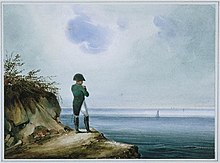Exile on Saint Helena

Refusing Napoleon's request for political asylum in England, the British kept Napoleon on the island of Saint Helena in the Atlantic Ocean, 1,870 km (1,162 mi) from the west coast of Africa. Napoleon arrived at Jamestown, Saint Helena in October 1815 on board the HMS Northumberland. The British also took the precaution of sending a small garrison of soldiers to both Saint Helena and the nearby uninhabited Ascension Island, which lay between St. Helena and Europe, to prevent any escape from the island.[221]
Napoleon stayed for two months at Briars pavilion before he was moved to Longwood House, a large wooden bungalow on Saint Helena, in December 1815. By this point, the house had fallen into disrepair. The location and interior of the house was damp, windswept and unhealthy.[222][223] The Times published articles insinuating the British government was trying to hasten his death. Napoleon often complained of the living conditions of Longwood House in letters to the island's governor and his custodian, Hudson Lowe,[224] while his attendants complained of "colds, catarrhs, damp floors and poor provisions."[225] Modern scientists have speculated that his later illness may have arisen from arsenic poisoning caused by copper arsenite in the wallpaper at Longwood House.[226]
With a small cadre of followers, Napoleon dictated his memoirs and grumbled about the living conditions. Lowe cut Napoleon's expenditure, ruled that no gifts were allowed if they mentioned his imperial status, and made his supporters sign a guarantee they would stay with the prisoner indefinitely.[227] When he held a dinner party, men were expected to wear military dress and "women [appeared] in evening gowns and gems. It was an explicit denial of the circumstances of his captivity".[228]
While in exile, Napoleon wrote a book about Julius Caesar, one of his great heroes.[229] He also studied English under the tutelage of Count Emmanuel de Las Cases with the main aim of being able to read English newspapers and books, as access to French newspapers and books was heavily restricted to him on Saint Helena.[230] Las Cases compiled the book The Memorial of Saint Helena about his time on the island with Napoleon; reflecting Napoleon's self-depictions, it depicts him as a liberal, visionary ruler for European unification, deposed by reactionary elements of the Ancien Régime.[231]
Another pastime of Napoleon's while in exile was playing card games.[232][233] The number of patiences named in his honour seems to suggest that he was an avid player of the solitary game. Napoleon at St Helena is described as being a favourite of his,[234] while Napoleon's Favourite (or St. Helena) is clearly a contender. Other games with a Napoleonic theme include Napoleon's Flank, Napoleon's Shoulder, Napoleon's Square and Little Napoleon Patience. However, Arnold argues that, while Napoleon played cards in exile, the notion that he played numerous patience games is "based on a misunderstanding".[232]
There were rumours of plots and even of his escape from Saint Helena, but in reality, no serious attempts were ever made.[235] For English poet Lord Byron, Napoleon was the epitome of the Romantic hero, the persecuted, lonely, and flawed genius.[236]
Death

Napoleon's personal physician, Barry O'Meara, warned the English government that his declining state of health was mainly caused by the harsh treatment. During the last few years of his life, Napoleon confined himself for months on end in his damp, mold-infested and wretched habitation of Longwood. Years of isolation and loneliness took its toll on Napoleon's mental health, having his court continually reduced, including the arrest of Count Emmanuel de Las Cases, conditions which Lord Holland used to bring about a debate regarding the treatment of Napoleon in captivity.[237]
In February 1821, Napoleon's health began to deteriorate rapidly, and he reconciled with the Catholic Church. By March, he had become confined to bed. Napoleon died on 5 May 1821 at Longwood House at age 51, after making his last confession, Extreme Unction and Viaticum in the presence of Father Ange Vignali from his deathbed. His last words were, France, l'armée, tête d'armée, Joséphine ("France, the army, head of the army, Joséphine").[238][239][231]
Shortly after his death, an autopsy was conducted and François Carlo Antommarchi, the doctor conducting the autopsy, cut off Napoleon's penis.[28][page needed][240] Napoleon's original death mask was created around 6 May, although it is not clear which doctor created it.[i][242] Napoleon's heart and intestines were removed and contained separately in two sealed vessels, which were placed inside his coffin at his feet. In his will, he had asked to be buried on the banks of the Seine, but the British governor said he should be buried on Saint Helena, in the Valley of the Willows.[238]
